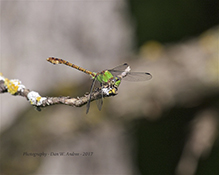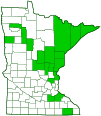rusty snaketail
(Ophiogomphus rupinsulensis)
Conservation • Description • Habitat • Ecology • Distribution • Taxonomy
|
|
||||||||||||||
Description |
Rusty snaketail is a medium-sized dragonfly. The thorax is bright green. There are two thin, brown shoulder stripes on each side but no bold stripes — the lateral and mid-frontal stripes are reduced and inconspicuous. The abdomen of the male is slender, yellow above, and rusty brown on the sides. There is a thin, white, snake-like stripe near the bottom (sublaterally) on each side. The undulating white stripe gives this genus the name “snaketails”. There are no distinct top spots. There are black V-shaped markings or blotches on abdominal segments 7 through 10. Segments 8, 9, and 10 are expanded into a noticeable “club”. The female is similarly colored but duller. The face is green. The large compound eyes are yellowish-green to bluish-green on the male, brownish on the female. They do not meet at the top of the head. The area behind the compound eyes at the top of the head (occiput) is bright green. The wings are clear except for dark stigmas. The wing triangle, a section of intersecting veins about 20% of the way from the base to the wingtip, is about the same size on the forewing and the hindwing. The legs are black, relatively short, and have yellow longitudinal stripes. |
Size |
Total length: 1¾″ to 2⅛″ |
Similar Species |
Common green darner (Anax junius) is much larger. The eyes meet at the top of the head. |
Habitat |
Silty rivers and large silty streams with moderately fast current. |
Ecology |
Season |
Mid-May to mid-August |
Behavior |
|
Life Cycle |
|
Naiad Food |
|
Adult Food |
|
Distribution |
||
|
Sources Biodiversity occurrence data published by: Minnesota Biodiversity Atlas (accessed through the Minnesota Biodiversity Atlas Portal, bellatlas.umn.edu, 8/2/2025). Haarstad, J. 1997. The dragonflies of selected eastern Minnesota rivers. Report submitted to the Minnesota Department of Natural Resources. Unpaged. Steffens, W. P., and W. A. Smith. 1999. Status survey for special concern and endangered dragonflies of Minnesota: population status, inventory and monitoring recommendations. Final report submitted to the Natural Heritage and Nongame Research Program, Minnesota Department of Natural Resources. 54 pp. |
|
| 8/2/2025 | ||
Occurrence |
||
Widespread and fairly common |
||
Taxonomy |
|
Order |
Odonata (Dragonflies and Damselflies) |
Suborder |
|
Superfamily |
Gomphoidea |
Family |
Gomphidae (clubtails) |
Genus |
Phanogomphus |
Superfamily Genus |
|
Subordinate Taxa |
|
|
|
Synonyms |
|
Gomphus carolinus Herpetogomphus pictus Herpetogomphus rupinsulensis Ophiogomphus carolinus |
|
Common Names |
|
rusty snaketail |
|
Glossary
Occiput
The back of the head. In Odonata, Megaloptera, and Neuroptera, the upper part of the head behind the eyes.
Stigma
In plants, the portion of the female part of the flower that is receptive to pollen. In Lepidoptera, an area of specialized scent scales on the forewing of some skippers, hairstreaks, and moths. In other insects, a thickened, dark, or opaque cell on the leading edge of the wing.
Visitor Photos |
||
Share your photo of this insect. |
||
This button not working for you? |
||
Dan W. Andree |
 |
An adult male Rusty Snaketail dragonfly. |
MinnesotaSeasons.com Photos |
||
|
||
|
||

Slideshows |
Rusty Snaketail |

|
Rusty Snaketail (Ophiogomphus rupinsulensis) |

|
Rusty Snaketail |

|

Visitor Videos |
||
Share your video of this insect. |
||
This button not working for you? |
||
Dan W. Andree |
"Rusty Snaketail Dragonfly" |
About
Published on Jul 29, 2017 A quick look at both adult male and female Rusty Snaketail dragonfly. I found them to be a colorful and interesting dragonfly around 2 inches in length. Though I approached them slowly and quietly they almost seemed curious of what I was - or was going to do. Enjoyed filming them. They seemed to have an almost curious friendly character. Added some background music. |
Other Videos |
||
|

Created: 1/28/2018 Last Updated: © MinnesotaSeasons.com. All rights reserved. |


